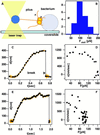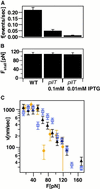Single pilus motor forces exceed 100 pN
- PMID: 12446837
- PMCID: PMC138556
- DOI: 10.1073/pnas.242523299
Single pilus motor forces exceed 100 pN
Erratum in
- Proc Natl Acad Sci U S A. 2003 May 13;100(10):6287
Abstract
Force production by type IV pilus retraction is critical for infectivity of Neisseria gonorrhoeae and DNA transfer. We investigated the roles of pilus number and the retraction motor, PilT, in force generation in vivo at the single-molecule level and found that individual retraction events are generated by a single pilus fiber, and only one PilT complex powers retraction. Retraction velocity is constant at low forces but decreases at forces greater than 40 pN, giving a remarkably high average stall force of 110 +/- 30 pN. Further insights into the molecular mechanism of force generation are gained from the effect of ATP-depletion, which reduces the rate of retraction but not the stall force. Energetic considerations suggest that more than one ATP is involved in the removal of a single pilin subunit from a pilus. The results are most consistent with a model in which the ATPase PilT forms an oligomer that disassembles the pilus by a cooperative conformational change.
Figures




Similar articles
-
High-force generation is a conserved property of type IV pilus systems.J Bacteriol. 2009 Jul;191(14):4633-8. doi: 10.1128/JB.00396-09. Epub 2009 May 8. J Bacteriol. 2009. PMID: 19429611 Free PMC article.
-
A force-dependent switch reverses type IV pilus retraction.Proc Natl Acad Sci U S A. 2004 Jul 27;101(30):10961-6. doi: 10.1073/pnas.0402305101. Epub 2004 Jul 15. Proc Natl Acad Sci U S A. 2004. PMID: 15256598 Free PMC article.
-
Motor Properties of PilT-Independent Type 4 Pilus Retraction in Gonococci.J Bacteriol. 2019 Aug 22;201(18):e00778-18. doi: 10.1128/JB.00778-18. Print 2019 Sep 15. J Bacteriol. 2019. PMID: 30692169 Free PMC article.
-
Using laser tweezers to measure twitching motility in Neisseria.Curr Opin Microbiol. 2005 Jun;8(3):344-9. doi: 10.1016/j.mib.2005.04.002. Curr Opin Microbiol. 2005. PMID: 15939360 Review.
-
Type IV pili and cell motility.Mol Microbiol. 1999 Apr;32(1):1-10. doi: 10.1046/j.1365-2958.1999.01339.x. Mol Microbiol. 1999. PMID: 10216854 Review.
Cited by
-
External Stresses Affect Gonococcal Type 4 Pilus Dynamics.Front Microbiol. 2022 Feb 25;13:839711. doi: 10.3389/fmicb.2022.839711. eCollection 2022. Front Microbiol. 2022. PMID: 35283813 Free PMC article.
-
Low-level pilin expression allows for substantial DNA transformation competence in Neisseria gonorrhoeae.Infect Immun. 2003 Nov;71(11):6279-91. doi: 10.1128/IAI.71.11.6279-6291.2003. Infect Immun. 2003. PMID: 14573647 Free PMC article.
-
Tyrosine-phosphorylated caveolin-1 blocks bacterial uptake by inducing Vav2-RhoA-mediated cytoskeletal rearrangements.PLoS Biol. 2010 Aug 24;8(8):e1000457. doi: 10.1371/journal.pbio.1000457. PLoS Biol. 2010. PMID: 20808760 Free PMC article.
-
Two ABC transporter operons and the antimicrobial resistance gene mtrF are pilT responsive in Neisseria gonorrhoeae.J Bacteriol. 2007 Jul;189(14):5399-402. doi: 10.1128/JB.00300-07. Epub 2007 May 11. J Bacteriol. 2007. PMID: 17496077 Free PMC article.
-
Flagella and pili-mediated near-surface single-cell motility mechanisms in P. aeruginosa.Biophys J. 2011 Apr 6;100(7):1608-16. doi: 10.1016/j.bpj.2011.02.020. Biophys J. 2011. PMID: 21463573 Free PMC article.
References
Publication types
MeSH terms
Substances
Grants and funding
LinkOut - more resources
Full Text Sources
Molecular Biology Databases

